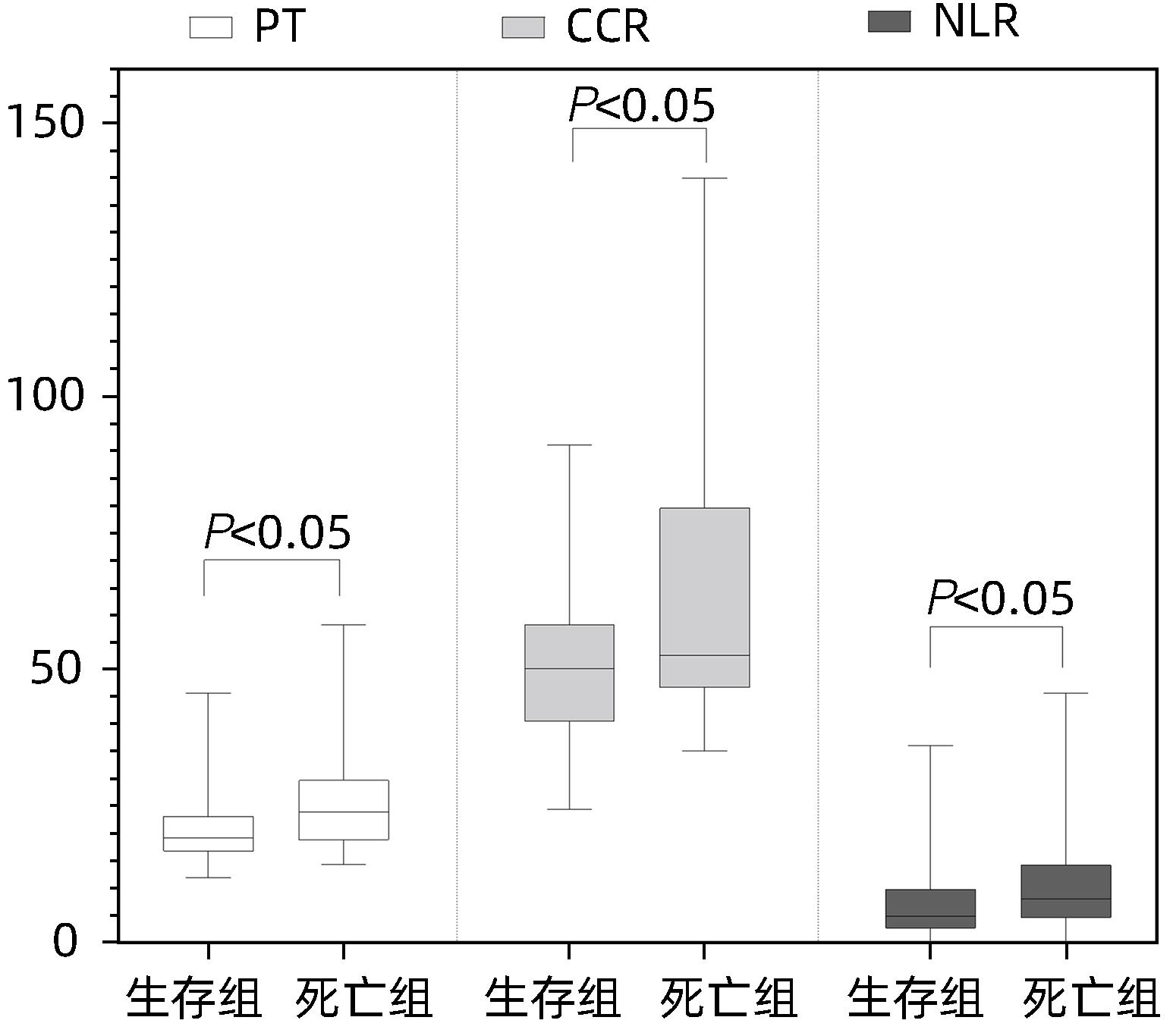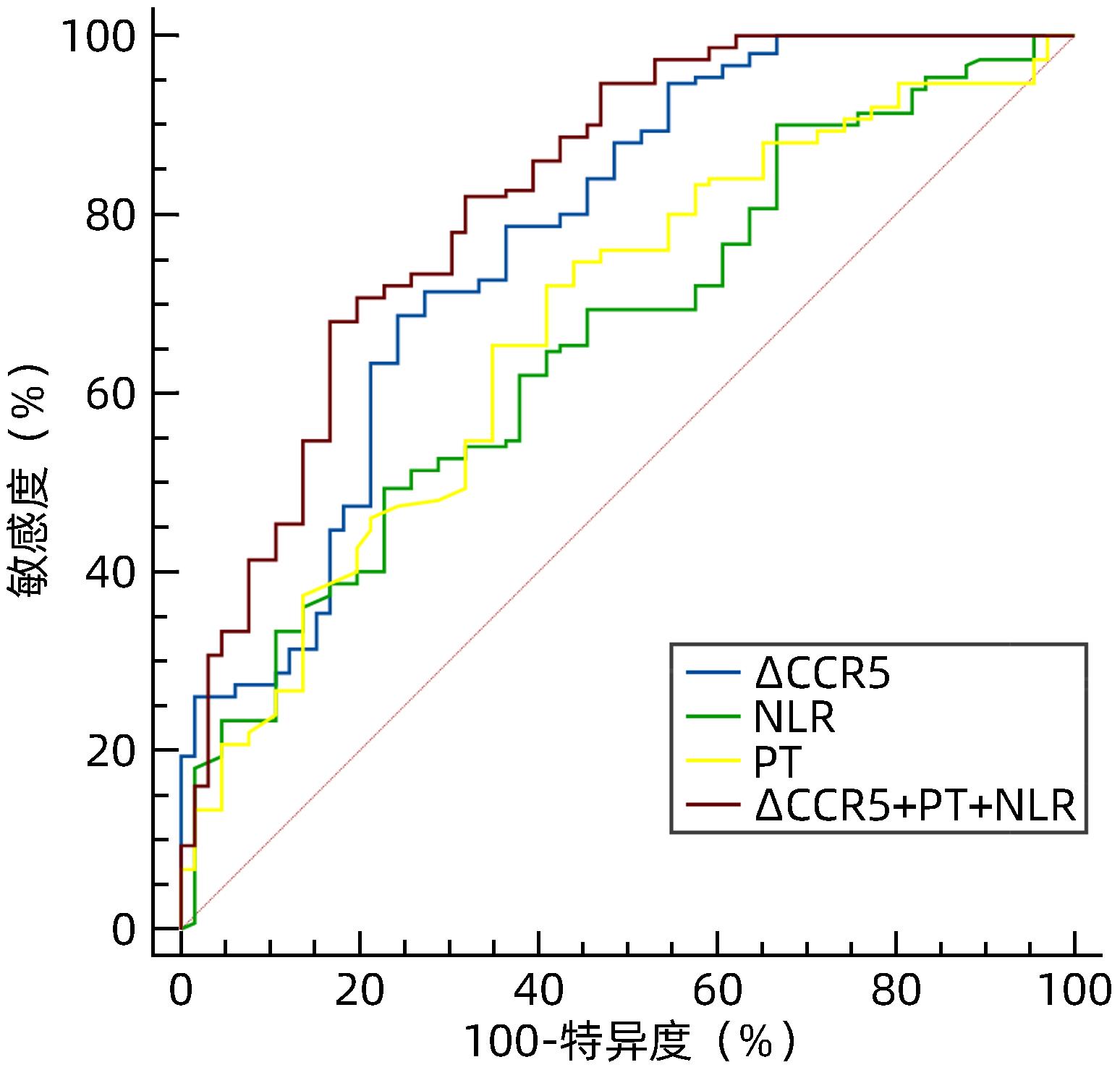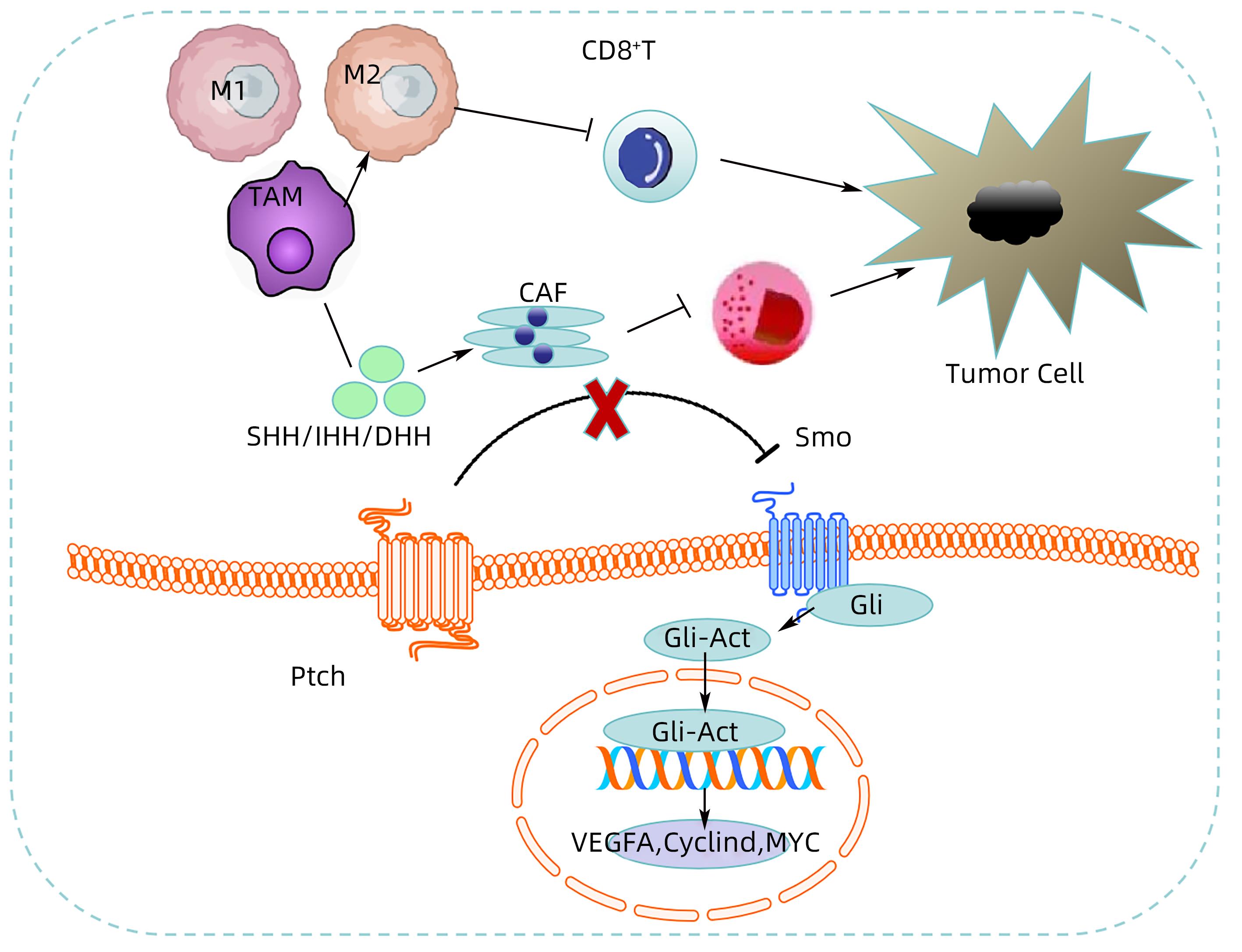血清肌酐与胱抑素C比值(CCR)对HBV相关慢加急性肝衰竭预后的评估价值
DOI: 10.12449/JCH240208
Value of serum creatinine-to-cystatin C ratio in assessing the prognosis of hepatitis B virus-related acute-on-chronic liver failure
-
摘要:
目的 探讨血清肌酐与胱抑素C比值(CCR)评估HBV相关慢加急性肝衰竭(HBV-ACLF)预后的临床价值。 方法 回顾性分析2021年1月—2022年11月苏州大学附属第一医院感染病科住院治疗的130例HBV-ACLF患者(治疗组)临床资料,根据治疗结局分为生存组(n=87)和死亡组(n=43);根据是否合并感染,分为感染组(n=37)和非感染组(n=93)。以同期30例健康体检者作为对照组。收集入院当天血常规指标,包括白细胞、血小板、中性粒细胞和淋巴细胞计数;观察入院当天、住院第5天、第10天、第15天血清肌酐、胱抑素C、血清Alb、PT,计算CCR、中性粒细胞与淋巴细胞比值(NLR)、血小板与淋巴细胞比值(PLR)、营养指数(PNI)、CCR5(入院后第5天CCR)、ΔCCR5(入院后第5天CCR-入院当天CCR)、CCR10(入院后第10天CCR)、ΔCCR10(入院后第10天CCR-入院后第5天CCR)、CCR15(入院后第15天CCR)、ΔCCR15(入院后第15天CCR-入院后第10天CCR),比较生存组和死亡组、感染组与非感染组上述指标的差异。计量资料两组间比较采用Mann-Whitney U检验;多组间比较采用Kruskal-Wallis H检验。单因素和多因素Logistic回归分析探讨影响疾病预后的因素;受试者工作特征曲线(ROC曲线)评估CCR对HBV-ACLF死亡事件的预测价值,ROC曲线下面积(AUC)比较采用DeLong检验。 结果 治疗组基线CCR、NLR、PNI、PT和Alb与健康对照组比较,差异均有统计学意义(P值均<0.001)。生存组与死亡组患者入院当天CCR、NLR、PT比较,差异均有统计学意义(P值均<0.05)。在130例HBV-ACLF患者中,有25例处于前期,48例处于早期,32例处于中期,25例处于晚期。各分期HBV-ACLF患者基线CCR、PLR及PT比较,差异均有统计学意义(P值均<0.05)。感染组与非感染组患者基线ΔCCR5、NLR比较,差异均有统计学意义(P值均<0.05)。患者入院第5天、第10天、第15天生存组与死亡组ΔCCR5、CCR10、CCR15比较,差异均有统计学意义(P值均<0.05)。多因素Logistic回归分析发现ΔCCR5(OR=1.175,95%CI:1.098~1.256,P<0.001)、NLR(OR=0.921,95%CI:0.880~0.964,P<0.001)和PT(OR=0.921,95%CI:0.873~0.973,P=0.003)是HBV-ACLF患者预后的独立影响因素。ΔCCR5的AUC为0.774,敏感度为0.687,特异度为0.757;ΔCCR5+PT+NLR联合的AUC为0.824,高于ΔCCR5、NLR、PT单独预测时的AUC(P值均<0.05)。 结论 ΔCCR5、NLR、PT可反映HBV-ACLF患者的病情及预后,是HBV-ACLF患者死亡事件的独立预测指标,ΔCCR5+PT+NLR联合时预测效能最佳。 -
关键词:
- 乙型肝炎病毒 /
- 慢加急性肝功能衰竭 /
- 肌酸酐 /
- 半胱氨酸蛋白酶抑制物C /
- 预后
Abstract:Objective To investigate the clinical value of serum creatinine-to-cystatin C ratio (CCR) in evaluating the prognosis of hepatitis B virus-related acute-on-chronic liver failure (HBV-ACLF). Methods A retrospective analysis was performed for the clinical data of 130 patients with HBV-ACLF (treatment group) who were hospitalized in Department of Infectious Diseases, The First Affiliated Hospital of Soochow University, from January 2021 to November 2022. According to the treatment outcome, they were divided into survival group with 87 patients and death group with 43 patients; according to the presence or absence of infection, they were divided into infection group with 37 patients and non-infection group with 93 patients. A total of 30 individuals who underwent physical examination during the same period of time were enrolled as control group. Routine blood test results were collected on the day of admission, including white blood cell count, platelet count, neutrophil count, and lymphocyte count; serum creatinine, cystatin C, serum albumin (Alb), and prothrombin time (PT) were observed on the day of admission and on days 5, 10, and 15 of hospitalization, and related indicators were calculated, including CCR, neutrophil-to-lymphocyte ratio (NLR), platelet-to-lymphocyte ratio (PLR), prognostic nutritional index (PNI), CCR5 (CCR on day 5 after admission), ΔCCR5 (CCR on day 5 after admission minus CCR on the day of admission), CCR10 (CCR on day 10 after admission), ΔCCR10 (CCR on day 10 after admission minus CCR on day 5 after admission), CCR15 (CCR on day 15 after admission), and ΔCCR15 (CCR on day 15 after admission minus CCR on day 10 after admission). The above indicators were compared between the survival group and the death group and between the infection group and the non-infection group. The Mann-Whitney U test was used for comparison of continuous data between two groups, and the Kruskal-Wallis H test was used for comparison between multiple groups. The univariate and multivariate logistic regression analyses were used to investigate the influencing factors for disease prognosis; the receiver operating characteristic (ROC) curve was used to assess the value of CCR in predicting HBV-ACLF death events, and the DeLong test was used for comparison of the area under the ROC curve (AUC). Results There were significant differences in CCR, NLR, PNI, PT, and Alb at baseline between the treatment group and the healthy control group (all P<0.001), and there were significant differences in CCR, NLR, and PT between the survival group and the death group on the day of admission (all P<0.05). Among the 130 patients with HBV-ACLF, there were 25 in the precancerous stage, 48 in the early stage, 32 in the intermediate stage, and 25 in the advanced stage, and there were significant differences in baseline CCR, PLR, and PT between the patients in different stages of HBV-ACLF (all P<0.05). There were significant differences in ΔCCR5 and NLR between the infection group and the non-infection group (P<0.05), and there were significant differences in ΔCCR5, CCR10, and CCR15 between the survival group and the death group (all P<0.05). The multivariate logistic regression analysis showed that ΔCCR5 (odds ratio [OR]=1.175, 95% confidence interval [CI]: 1.098 — 1.256, P<0.001), NLR (OR=0.921, 95%CI: 0.880 — 0.964, P<0.001), and PT (OR=0.921, 95%CI: 0.873 — 0.973, P=0.003) were independent influencing factors for the prognosis of HBV-ACLF patients. ΔCCR5 had an AUC of 0.774, a sensitivity of 0.687, and a specificity of 0.757, and the AUC of ΔCCR5+PT+NLR was 0.824, which was significantly higher than the AUC of ΔCCR5, NLR, or PT alone (all P<0.05). Conclusion ΔCCR5, NLR, and PT can reflect the condition and prognosis of patients with HBV-ACLF and are independent predictive indicators for death events in patients with HBV-ACLF. The combination ofΔCCR5, PT, and NLR has the best predictive efficiency. -
Key words:
- Hepatitis B Virus /
- Acute-On-Chronic Liver Failure /
- Creatinine /
- Cystatin C /
- Prognosis
-
肝细胞癌(HCC)是全球范围内最常见的恶性肿瘤之一。我国HCC的发病率及死亡率居高不下,给国家以及社会带来了巨大的经济负担[1]。由于HCC的起病隐匿,大多数患者确诊时已处于疾病晚期,故HCC的治疗效果不佳,预后普遍很差。随着研究的不断深入,科学家不仅研究突变的癌细胞本身,还研究癌细胞周围环境以及它们之间的功能串扰。越来越多的证据[2-3]表明肿瘤微环境(tumor microenvironment,TME)对肿瘤发展起到十分重要的作用,通过重塑TME来调控肿瘤进展成为新的研究热点。Hedgehog(Hh)通路是一种有效的致癌驱动信号,可促进肿瘤的增殖、存活、血管生成、侵袭转移、代谢重组及上皮间质转换等多种癌症特征[4],但其在抗肿瘤免疫反应调节中的作用在近年的研究中才逐渐得到关注[5]。Hh信号通路在HCC发生和HCC的TME中起重要作用。Hh信号的异常激活可能加速了肝癌的生长。Hh信号和TME之间的相互串扰影响肿瘤生长、免疫耐受、炎症和耐药[6]。本文就Hh信号异常激活在肝癌和肝癌TME中的作用及机制的研究现状与潜在的治疗意义作一综述。
1. Hh信号通路的结构与功能
1980年Nüsslein-Volhard等[7]学者在果蝇中发现的Hh信号分子,是一种由信号细胞所分泌的局域性蛋白质配体。Hh基因能使果蝇的幼虫虫体长出许多刺突,形似刺猬,故名“刺猬通路”。在哺乳动物体内Hh通路主要由3个Hh家族成员[音速刺猬(Sonic Hedgehog,SHH)、印度刺猬(Indian Hedgehog,IHH)、沙漠刺猬(Desert Hedgehog,DHH)]、2个跨膜受体[Pathed (Ptch)和Smoothened(Smo)]、3个Gli蛋白(Gli1、Gli2和Gli3),以及下游的靶基因等组成[8]。3个Hh同源基因,编码3种SHH、IHH、DHH的蛋白配体,它们均由具有信号活性功能的氨基端(Hh-N)和有自身蛋白水解酶活性及胆固醇转移酶功能的羧基端(Hh-C)组成。Ptch蛋白家族成员都是含12次跨膜结构域的膜蛋白,能与Hh结合,对Hh信号通路起负调控作用。Smo是一种7次跨膜受体,是Hh信号传递所必需的受体[8-9]。当没有Hh配体蛋白时,Ptch能释放抑制Smo活性的蛋白,从而阻滞Smo的激活,使得Hh信号通路关闭。而当Hh配体蛋白(SHH、IHH或DHH)与Ptch结合后,Ptch停止分泌,Smo解除抑制,Hh信号系统被激活,最终导致Gli转录因子成员的激活、向细胞核转移,上调Hh通路下游靶基因如VEGF、Myc、Cyclin D等,从而促进肿瘤增殖、侵袭、转移、血管生成等[10]。
2. Hh信号通路在HCC发生发展中的作用
Hh信号通路在胚胎发育过程中发挥着十分重要的作用,可以诱导内胚祖细胞向肝细胞分化[11],当胚胎成熟时,这一途径就会失活。健康成年人的肝细胞几乎不表达Hh配体,因此Hh信号通路并不活跃。当各种急、慢性肝损伤发生时,如乙型或丙型肝炎、酒精性肝病、非酒精性脂肪性肝病、胆汁淤积性肝损伤、肝大部分切除等,Hh信号显著重新激活[12-13]。虽然Hh通路的瞬时激活有助于急性损伤后的肝再生,但是旁分泌Hh信号的持续诱导会使肝上皮细胞和邻近间质细胞之间平衡改变,促进肝纤维化、肝硬化和肝癌的发生[14]。
在HCC中,Hh通路的激活支持了肿瘤细胞的生长,并且使得肝癌发展不同阶段的凋亡减少[15]。在肝癌组织和肝癌细胞系中,Hh信号通路中的重要成分表达增高,通常与肝癌的恶性程度、淋巴结转移等密切相关[16-17]。Chen等[18]研究表明靶向抑制Gli1,不仅可以通过抑制Hh信号抑制肝癌的生长,还可以通过下调基质金属蛋白酶2(MMP-2)、MMP-9,阻断上皮间质转化来抑制HCC的迁移和侵袭。因此,抑制或干扰Gli1表达可以抑制肿瘤的进展。He等[19]研究结果显示,LINC01093能与胰岛素样生长因子2 mRNA结合蛋1(IGF2BP1)结合,干扰IGF2BP1与胶质瘤相关癌基因同源物1(Gli1 mRNA)之间的相互作用,其结果是导致Gli1 mRNA的降解,而LINC01093过表达可显著抑制肝癌细胞的增殖和转移。相反,它的敲除促进了HCC的进展。Huang等[20]研究表明,在切除的肝癌组织中Smo和miR-338-3p的表达呈负相关,miR-338-3p的表达缺失与HCC的临床侵袭性有关,Smo的激活导致c-MYC的过表达,促进肝癌的发生发展,miR338-3p可通过抑制Smo介导的MMP-9的表达来抑制肝癌细胞的体外侵袭。以上研究结果均表明,Hh的异常激活与肝癌的发生发展密切相关,抑制Hh通路相关因子可以延缓肝癌的进展。近年来随着TME研究的深入,发现激活的Hh信号可以通过影响肿瘤干细胞(cancer stem cell,CSC)干性等调节肿瘤耐药,而且阻断Hh信号通路能够逆转肿瘤耐药[21]。Gu等[22]学者的研究发现,环状RNA CircIPO11激活Hh信号能驱动CSC的自我更新,促进肝癌的生长。究其本质原因可能是CircIPO11能将TOP1招募到Gli1启动子上,触发其转录,导致Hh的激活。
总之Hh信号通路在进化上是保守的,与胚胎发育、正常组织修复、上皮间质转化、CSC干性维持以及肝癌的发生进展密切相关[23]。
3. 肝癌TME中的Hh信号转导
TME是一个复杂的、不断进化的实体,是指肿瘤在其发生发展过程中所处的内环境,作为肿瘤免疫效应阶段的执行场所,TME参与肝癌的免疫耐受和应答,影响肝癌的发展和预后[24]。在肝癌生长的早期,肝癌细胞及支持其存活、侵袭、转移的TME成分之间形成了一种动态和相互作用的关系。为了克服低氧和酸性的微环境,TME协调促进血管生成的过程,以恢复氧气和营养供应,并清除代谢废物。在此期间,肿瘤被各种适应性免疫细胞和先天免疫细胞侵染,根据环境的不同,这些细胞既可以执行抗肿瘤功能,抑制肿瘤进展,还可以促进肿瘤生长[25](图1)。
 注: 当没有Hh配体蛋白时,Ptch能释放抑制Smo活性的蛋白,从而阻滞Smo的激活,使得Hh信号通路关闭。而当Hh配体蛋白(SHH、IHH或DHH)与Ptch结合后,Ptch停止分泌,Smo解除抑制,Hh信号系统被激活,最终导致Gli转录因子成员的激活、向细胞核转移,上调Hh通路下游靶基因如VEGF、Myc、Cyclin D等,从而促进肿瘤增殖、侵袭、转移等;细胞中的Hh信号能驱动肿瘤间质中肿瘤相关巨噬细胞(TAM)的M2极化,抑制CD8+T淋巴细胞功能,从而促进肿瘤的生长;细胞中异常激活的Hh信号和肿瘤相关成纤维细胞(CAF)相互作用并协同促进肿瘤的发展。图 1 肝癌TME中的Hh信号转导Figure 1. Hh signal transduction in TME of hepatocellular carcinoma
注: 当没有Hh配体蛋白时,Ptch能释放抑制Smo活性的蛋白,从而阻滞Smo的激活,使得Hh信号通路关闭。而当Hh配体蛋白(SHH、IHH或DHH)与Ptch结合后,Ptch停止分泌,Smo解除抑制,Hh信号系统被激活,最终导致Gli转录因子成员的激活、向细胞核转移,上调Hh通路下游靶基因如VEGF、Myc、Cyclin D等,从而促进肿瘤增殖、侵袭、转移等;细胞中的Hh信号能驱动肿瘤间质中肿瘤相关巨噬细胞(TAM)的M2极化,抑制CD8+T淋巴细胞功能,从而促进肿瘤的生长;细胞中异常激活的Hh信号和肿瘤相关成纤维细胞(CAF)相互作用并协同促进肿瘤的发展。图 1 肝癌TME中的Hh信号转导Figure 1. Hh signal transduction in TME of hepatocellular carcinoma3.1 Hh信号与肿瘤相关成纤维细胞(cancer-associated fibroblasts,CAF)相互作用促进肿瘤增殖
CAF是TME中最重要的间质成分之一[26]。活化的CAF在细胞外基质重塑、癌细胞增殖、代谢重编程、侵袭、干性和其他恶性行为,以及在肿瘤血管生成、转移、免疫抑制和治疗耐药等方面发挥重要调节作用[27-28]。Hh信号通路是上述过程中的关键参与者之一[4]。CAF不仅是TME中Hh配体的潜在来源,而且还通过激活Gli1来响应Hh信号。
CAF在细胞来源、表型和功能等方面表现出生物异质性[29]。但它们都表达某些间充质标志物,包括α-SMA、Vimentin和FSP-1。大多数CAF亚群通常表现出促癌作用,通过不同的途径参与肿瘤发展的多个阶段[9,30-31]。CAF不仅可以促进肿瘤的增殖,而且诱导癌细胞的免疫逃避[32-34]。此外,CAF还能够通过释放MMP来降解细胞外基质,同时合成新的基质蛋白,为肿瘤侵袭和血管生成提供结构支持[35-36]。异常激活的Hh信号和CAF相互作用并协同促进肿瘤的发展[37],比如,在肺部肿瘤中Hh信号的激活增加了CAF中Forkhead Box F1的表达,调节了这些成纤维细胞的收缩能力以及肝细胞生长因子(hepatocyte growth factor,HGF)和成纤维细胞生长因子2(fibroblast growth factor 2,FGF2)的产生,从而刺激肺癌细胞的迁移[38]。在乳腺癌中的CSC可以分泌SHH作为旁分泌信使,激活CAF中的Hh信号,从而产生CSC自我更新的因子,加速CSC扩增[39]。乳腺癌细胞产生的Hh配体能使CAF重新编程,提供支持CSC的免疫微环境,还能通过表达FGF5和产生纤维状胶原导致化疗耐药[40]。肝脏肿瘤多由肝纤维化或肝硬变发展而来,肝癌细胞始终嵌入在富含CAF的微环境中。CAF能够增加肝癌细胞的增殖和侵袭性[41],CAF来源的外切体已被报道参与调节HCC的TME。Liu等[42]研究表明,CAF来源的CCL2、CCL5、CCL7和CXCL16通过诱导肝癌细胞中Hh和转化生长因子-β通路的激活而促进肝癌转移。因此可以推论:CAF与肿瘤之间通过异常激活Hh信号相互串扰是促进肿瘤发展的重要因素之一。通过抑制Hh信号通路进而抑制肿瘤进展,以期为肝癌治疗提供新的方法。
3.2 Hh信号、肿瘤相关巨噬细胞(tumor-associated macrophages,TAM)和T淋巴细胞之间的相互作用促进肿瘤免疫耐受
研究[43-45]表明,从包括基底细胞癌、乳腺癌、肝癌、结直肠癌和胰腺癌在内的一系列癌症中分泌的Hh配体可以调节间质细胞,创造促进癌症进展的有利环境。然而,Hh配体如何作用于TME内的间质细胞以促进肿瘤生长以及参与这一过程的细胞类型仍有待阐明。TAM是TME的重要组成部分,在某些实体肿瘤中,TAM可占TME的50%[46]。TAM功能可塑性极强,并能够快速适应微环境的变化,通过为恶性细胞提供营养支持来促进肿瘤疾病的进展、免疫逃逸和耐药[47-48]。此外,TAM具有空间异质性,可以根据其所占据的TME的特定区域获得特殊的功能状态。在TME中,TAM通常表现为抗炎的M2样表型,以促进肿瘤生长。TME的缺氧区和坏死区富含M2样TAM,尽管其抗原提呈能力有限,流动性低,但是会分泌大量的肿瘤支持因子以促进肿瘤生长,而血管周围区域的TAM亚群具有强大的促血管生成功能和免疫抑制特性[49]。CD8+T淋巴细胞是肿瘤浸润淋巴细胞中的主要抗瘤细胞,可以通过细胞接触的方式释放穿孔素、颗粒酶B、IFN-γ、TNF等细胞因子杀伤靶细胞[50]。十分遗憾的是,TME中CD8+T淋巴细胞常常表现为耗竭状态,这也是促进肿瘤生长和发生免疫逃逸的重要机制之一[51]。而且有研究[5]表明,TAM向M2型转化,在肝癌中介导了CD8+T淋巴细胞的耗竭。Petty等[5]学者通过肝癌小鼠模型发现,髓系细胞中的Hh信号能驱动肿瘤间质中TAM的M2极化,从而促进肿瘤的生长,深入研究表明,肿瘤来源的SHH主要是通过转录因子Krüppel样因子4直接作用于TAM,促进M2极化。肿瘤细胞和TAM之间Hh通信的缺失会干扰TAM M2极化,导致肿瘤生长受阻。此外,Hh诱导的TAM产生CXCL9和CXCL10来抑制CD8+T淋巴细胞向TME的募集。该团队另一项研究[52]还发现,Hh能诱导TAM上的细胞程序性死亡配体1(PD-L1)表达,进而抑制肿瘤浸润性CD8+T淋巴细胞杀伤能力和细胞毒性。Tan等[53]学者也得出了同样的结论,他们观察到,在临床上HCC患者经肝动脉化疗栓塞术(TACE)治疗后,TME中CD8+T淋巴细胞的数量减少且抗肿瘤的功能下降。究其具体原因可能是因为TACE治疗后肿瘤组织中TREM2+TAM数量增加,分泌CXCL9的水平降低,Gal-1释放增加,Gal-1可以上调血管内皮细胞的PD-L1,从而抑制CD8+T淋巴细胞向肿瘤组织中募集,还抑制CD8+T淋巴细胞的杀伤功能。抑制TREM2能增强抗PD-L1药物对HCC的治疗效果。
因此,在TME中,Hh信号和TAM共同影响CD8+T淋巴细胞的功能,进而促进肿瘤免疫耐受。通过靶向Hh信号通路,还可能成为调节间质细胞与浸润性免疫细胞之间直接和间接相互作用的关键,可为肝脏肿瘤治疗提供新的思路。
4. Hh信号和TME可作为肝脏肿瘤潜在的治疗靶点
Hh信号成分的表达水平与包括HCC在内的人类恶性肿瘤的发生发展密切相关。Jeng等[17]在一项前瞻性研究中纳入2006—2010年的50例肝癌根治性切除术后患者。检测SHH、Ptch-1和Gli1在肝癌组织和配对的非癌肝组织中的mRNA表达并比较复发组与未复发组的临床病理特征及复发率。结果显示Ptch-1 mRNA及Gli1 mRNA与血清甲胎蛋白水平、肿瘤大小、肿瘤分期显著相关。Gli1基因在肿瘤及癌旁肝组织中的同时阳性表达与临床预后显著相关[18]。这些数据均表明Hh通路的激活在肝癌的发展中必不可少,Gli1可作为肝癌预后的一个预测指标,也可作为一个强大的激活剂来介导和放大Hh反应[54-55]。Chen等[56]还发现Gli1的过度表达与HCC的包膜侵犯、晚期肿瘤分期、血管侵犯和肝内转移有关。综上,Hh信号成分的表达水平是肝癌预后的有用标志物,Hh通路可能是HCC潜在的治疗靶点。
目前学者们已经致力于Hh抑制剂的研发,美国食品药物监督管理局已批准三种针对Smo的药物。但是Smo突变或Smo非依赖的Hh途径激活增加了对新型Hh抑制剂的需求。下游效应子Gli抑制剂是克服耐药的主要策略。目前抑制Hh信号转导的药物包括5E1(抗SHH)、环多巴胺、Vismodegib、Sonidegib(抗Smo)、ATO、Gant-58、Gant-61(抗Gli1/Gli2转录因子)等[57]。GDC-0449(Vismodegib)作为获批上市的口服全身性刺激素拮抗剂,可以与Smo结合发挥作用,已证实在基底细胞癌和髓母细胞瘤的治疗中取得了令人鼓舞的结果[58-60]。在肝癌的治疗中,Pinter等[61]证实,Hh途径抑制剂GDC-0449通过抑制Hh通路相关蛋白,在体外下调肿瘤血管内皮生长因子的产生,并抑制大鼠肝癌模型中肿瘤组织的血管生成和肿瘤生长。GANT61作为Gli1和Gli2的小分子抑制剂,能诱导体外培养的肝癌细胞自噬和凋亡。在小鼠异种移植肿瘤模型中,GANT61则表现为抑制肿瘤生长[62]。而且还有一些证据[23-25]表明,旁分泌的SHH信号的传递,能强烈影响TME的间质细胞。肿瘤来源的SHH,不仅可以直接作用于TAM促进M2极化,诱导TAM上的PD-L1表达,而且还可以抑制TAM产生CXCL9和CXCL10来抑制CD8+T淋巴细胞向TME的募集[5],进而抑制肿瘤浸润性CD8+T淋巴细胞杀伤能力和细胞毒性,加速肿瘤进展。通过抑制Hh通路来改善免疫抑制微环境可能是一种新的治疗肿瘤的方法。
Hh通路作为HCC潜在的治疗靶点,更深入地了解其作用机制以及Hh与TME的串扰,有望为肝脏肿瘤的治疗策略提供新的见解。
5. 小结
Hh信号通路的异常激活在肝脏肿瘤的发生进展中发挥着重要作用。事实上,Hh信号的异常激活不仅导致肿瘤细胞的增殖,增加肿瘤侵袭、转移、血管复建等恶性表型,Hh还直接调控肿瘤干细胞表型特征的表达介导肿瘤耐药。Hh配体通过调节巨噬细胞和T淋巴细胞的免疫反应以及肿瘤相关炎症因子的表达,促进抑制型肿瘤免疫微环境的建立。因此Hh不仅是肿瘤增殖的促进剂,而且是导致免疫抑制微环境形成、T淋巴细胞耗竭以及肿瘤免疫逃逸的关键,故通过抑制Hh信号来治疗肝脏肿瘤有望成为HCC行之有效的新的治疗方法。
-
表 1 治疗组与健康对照组基线指标比较
Table 1. Comparison of baseline indexes between the treatment group and the healthy control group
指标 健康对照组(n=30) 治疗组(n=130) Z值 P值 男/女(例) 15/15 78/52 χ2=-1.233 0.190 年龄(岁) 52(47~76) 53(42~66) Z=-0.638 0.524 CCR(μmol/mg) 74.67(64.54~83.18) 51.22(43.35~62.33) Z=-6.378 <0.001 NLR 1.88(1.35~2.24) 5.81(2.89~11.11) Z=-6.745 <0.001 PLR 109.00(88.54~123.89) 96.77(57.38~146.99) Z=-1.437 0.151 PNI 51.80(49.34~54.80) 34.50(30.70~38.10) Z=-8.418 <0.001 PT(s) 10.90(10.38~11.75) 19.70(17.60~25.80) Z=-8.881 <0.001 Alb(g/L) 42.90(41.08~44.30) 29.10(26.53~32.60) Z=-8.746 <0.001 表 2 HBV-ACLF患者不同分期基线指标比较
Table 2. Baseline markers of HBV-ACLF at different stages were compared
指标 前期(n=25) 早期(n=48) 中期(n=32) 晚期(n=25) H值 P值 CCR(μmol/mg) 43.85(38.01~53.55) 53.01(43.18~64) 51.69(44.95~60.57) 56.84(46.43~80.44) 19.816 <0.001 NLR 5.70(2.38~10.69) 6.58(3.43~12.38) 5.55(2.80~10.45) 7.64(2.77~11.25) 2.070 0.558 PLR 77.38(52.27~140.63) 106.96(65.79~188.73) 69.44(50.18~143.86) 78.21(54.02~120.69) 13.698 0.003 PNI 32.65(30.60~37.25) 34.55(30.50~38.85) 33.90(29.35~37.65) 36.25(32.35~39.55) 5.949 0.114 PT(s) 17.60(16.25~19.05) 18.20(16.20~19.50) 24.00(22.50~26.05) 33.10(30.30~41.00) 187.731 <0.001 Alb(g/L) 28.70(26.20~30.50) 28.80(26.40~32.70) 29.10(26.10~32.90) 29.80(28.00~33.20) 3.285 0.350 表 3 非感染组与感染组基线指标比较
Table 3. Comparison of baseline indexes between infected group and non-infected group
指标 感染组(n=37) 非感染组(n=93) Z值 P值 CCR(μmol/mg) 54.17(40.49~66.08) 50.74(43.78~62.33) -1.098 0.272 NLR 12.38(7.64~16.29) 4.65(2.70~7.98) -6.363 <0.001 PLR 107.53(57.86~168.42) 93.18(60.34~145.16) -0.414 0.679 PNI 35.65(31.20~38.65) 34.20(30.50~37.80) -0.630 0.529 PT(s) 18.60(16.60~24.75) 20.30(17.50~25.10) -0.623 0.533 Alb(g/L) 28.70(25.25~32.40) 29.10(26.70~32.30) -0.416 0.678 ΔCCR5(μmol/mg) -13.94(-22.19~-5.48) -9.41(-13.40~-5.04) -2.675 0.007 表 4 死亡组与生存组患者入院第5天、第10天、第15天CCR动态比较
Table 4. Dynamic comparison of CCR in death group and survival group at 5、10 and 15 days after admission
指标 死亡组(n=43) 生存组(n=87) Z值 P值 CCR5(μmol/mg) 39.70(32.32~46.86) 40.80(37.00~49.37) -0.360 0.719 ΔCCR5(μmol/mg) -18.43(-70.19~-13.40) -9.41(-11.25~-3.49) -5.380 <0.001 CCR10(μmol/mg) 40.00(1.82~44.62) 39.32(33.65~49.04) -2.410 0.016 ΔCCR10(μmol/mg) -4.89(-32.44~-0.69) -3.44(-5.56~1.47) -1.674 0.094 CCR15(μmol/mg) 27.84(24.69~34.43) 37.60(31.64~46.86) -3.480 <0.001 ΔCCR15(μmol/mg) -7.55(-12.16~22.87) -2.64(-7.49~2.09) -1.323 0.186 表 5 基线指标单因素及多因素Logistic回归分析
Table 5. The baseline indexes were analyzed by binary single factor and multivariate Logistic regression
指标 单因素分析 多因素分析 OR(95%CI) P值 OR(95%CI) P值 ΔCCR5(μmol/mg) 1.163(1.101~1.228) <0.001 1.175(1.098~1.256) <0.001 PT(s) 0.912(0.876~0.950) <0.001 0.921(0.873~0.973) 0.003 NLR 0.948(0.917~0.980) 0.001 0.921(0.880~0.964) <0.001 CCR(μmol/mg) 0.959(0.943~0.976) <0.001 1.006(0.976~1.036) 0.713 PLR 1.003(0.999~1.007) 0.191 PNI 0.997(0.976~1.018) 0.780 Alb(g/L) 0.993(0.937~1.051) 0.798 表 6 ΔCCR5、PT、NLR、ΔCCR5+PT+NLR预测HBV-ACLF患者死亡事件效能分析
Table 6. Efficacy analysis of ΔCCR5, PT, NLR, ΔCCR5+PT+NLR in predicting death events in patients with HBV-ACLF
变量 AUC 95%CI P值 最佳临界值 敏感度 特异度 约登指数 PT(s) 0.704 0.643~0.761 <0.001 21.500 0.710 0.650 0.360 NLR 0.645 0.581~0.705 <0.001 4.610 0.481 0.762 0.244 ∆CCR5(μmol/mg) 0.774 0.712~0.828 <0.001 -10.150 0.687 0.757 0.444 ∆CCR5+PT+NLR 0.824 0.767~0.873 <0.001 0.700 0.680 0.833 0.513 -
[1] Chinese Society of Hepatology, Chinese Medical Association; Chinese Society of Gastroenterology, Chinese Medical Association. Clinical guidelines on nutrition in end-stage liver disease[J]. J Clin Hepatol, 2019, 35( 6): 1222- 1230. DOI: 10.3969/j.issn.1001-5256.2019.06.010.中华医学会肝病学分会, 中华医学会消化病学分会. 终末期肝病临床营养指南[J]. 临床肝胆病杂志, 2019, 35( 6): 1222- 1230. DOI: 10.3969/j.issn.1001-5256.2019.06.010. [2] MANGANA DEL RIO T, SACLEUX SC, VIONNET J, et al. Body composition and short-term mortality in patients critically ill with acute-on-chronic liver failure[J]. JHEP Rep, 2023, 5( 8): 100758. DOI: 10.1016/j.jhepr.2023.100758. [3] NISHIKAWA H, SHIRAKI M, HIRAMATSU A, et al. Japan Society of Hepatology guidelines for sarcopenia in liver disease(1st edition): Recommendation from the working group for creation of sarcopenia assessment criteria[J]. Hepatol Res, 2016, 46( 10): 951- 963. DOI: 10.1111/hepr.12774. [4] PENG H, ZHANG Q, LUO L, et al. A prognostic model of acute-on-chronic liver failure based on sarcopenia[J]. Hepatol Int, 2022, 16( 4): 964- 972. DOI: 10.1007/s12072-022-10363-2. [5] SANCHEZ-RODRIGUEZ D, MARCO E, CRUZ-JENTOFT AJ. Defining sarcopenia: Some caveats and challenges[J]. Curr Opin Clin Nutr Metab Care, 2020, 23( 2): 127- 132. DOI: 10.1097/MCO.0000000000000621. [6] SAYER AA, CRUZ-JENTOFT A. Sarcopenia definition, diagnosis and treatment: Consensus is growing[J]. Age Ageing, 2022, 51( 10): afac220. DOI: 10.1093/ageing/afac220. [7] KASHANI KB, FRAZEE EN, KUKRÁLOVÁ L, et al. Evaluating muscle mass by using markers of kidney function: Development of the sarcopenia index[J]. Crit Care Med, 2017, 45( 1): e23- e29. DOI: 10.1097/CCM.0000000000002013. [8] WANG S, XIE L, XU J, et al. Predictive value of serum creatinine/cystatin C in neurocritically ill patients[J]. Brain Behav, 2019, 9( 12): e01462. DOI: 10.1002/brb3.1462. [9] JUNG CY, KIM HW, HAN SH, et al. Creatinine-cystatin C ratio and mortality in cancer patients: A retrospective cohort study[J]. J Cachexia Sarcopenia Muscle, 2022, 13( 4): 2064- 2072. DOI: 10.1002/jcsm.13006. [10] Liver Failure and Artificial Liver Group, Chinese Society of Infectious Diseases, Chinese Medical Association; Severe Liver Disease and Artificial Liver Group, Chinese Society of Hepatology, Chinese Medical Association. Guideline for diagnosis and treatment of liver failure(2018)[J]. J Clin Hepatol, 2019, 35( 1): 38- 44. DOI: 10.3969/j.issn.1001-5256.2019.01.007.中华医学会感染病学分会肝衰竭与人工肝学组, 中华医学会肝病学分会重型肝病与人工肝学组. 肝衰竭诊治指南(2018年版)[J]. 临床肝胆病杂志, 2019, 35( 1): 38- 44. DOI: 10.3969/j.issn.1001-5256.2019.01.007. [11] LI JQ, LIANG X, YOU SL, et al. Development and validation of a new prognostic score for hepatitis B virus-related acute-on-chronic liver failure[J]. J Hepatol, 2021, 75( 5): 1104- 1115. DOI: 10.1016/j.jhep.2021.05.026. [12] GAO FY, ZHANG QQ, LIU Y, et al. Nomogram prediction of individual prognosis of patients with acute-on-chronic hepatitis B liver failure[J]. Dig Liver Dis, 2019, 51( 3): 425- 433. DOI: 10.1016/j.dld.2018.08.023. [13] SUN ZY, LIU XL, WU DX, et al. Circulating proteomic panels for diagnosis and risk stratification of acute-on-chronic liver failure in patients with viral hepatitis B[J]. Theranostics, 2019, 9( 4): 1200- 1214. DOI: 10.7150/thno.31991. [14] BEER L, BASTATI N, BA-SSALAMAH A, et al. MRI-defined sarcopenia predicts mortality in patients with chronic liver disease[J]. Liver Int, 2020, 40( 11): 2797- 2807. DOI: 10.1111/liv.14648. [15] JIN L, LI X. MRI-defined sarcopenia predicts mortality in patients with chronic liver disease[J]. Liver Int, 2021, 41( 1): 223. DOI: 10.1111/liv.14691. [16] WANG T, ZHANG YG, LI QQ, et al. Evaluation value of area index of the third lumbar psoas major muscle in nutritional status and prognosis of patients with cirrhosis[J]. Clin J Med Offic, 2022, 50( 7): 729- 732. DOI: 10.16680/j.1671-3826.2022.07.18.王然, 张永国, 李谦谦, 等. 第三腰椎腰大肌面积指数对肝硬化患者营养状态及预后评估价值[J]. 临床军医杂志, 2022, 50( 7): 729- 732. DOI: 10.16680/j.1671-3826.2022.07.18. [17] Society of Infectious Diseases, Chinese Medical Association. Expert consensus on diagnosis and treatment of end-stage liver disease complicated with infections(2021 version)[J]. J Clin Hepatol, 2022, 38( 2): 304- 310. DOI: 10.3969/j.issn.1001-5256.2022.02.010.中华医学会感染病学分会. 终末期肝病合并感染诊治专家共识(2021年版)[J]. 临床肝胆病杂志, 2022, 38( 2): 304- 310. DOI: 10.3969/j.issn.1001-5256.2022.02.010. [18] WANG XB, ZHANG Q, GAO FY. Prediction of acute-on-chronic liver failure and integrated traditional Chinese and Western medicine therapy[J]. J Clin Hepatol, 2020, 36( 1): 19- 25. DOI: 10.3969/j.issn.1001-5256.2020.01.003.王宪波, 张群, 高方媛. 慢加急性肝衰竭的预后评估及中西医结合治疗[J]. 临床肝胆病杂志, 2020, 36( 1): 19- 25. DOI: 10.3969/j.issn.1001-5256.2020.01.003. [19] HAINES RW, ZOLFAGHARI P, WAN Y, et al. Elevated urea-to-creatinine ratio provides a biochemical signature of muscle catabolism and persistent critical illness after major trauma[J]. Intensive care medicine, 2019, 45( 12): 1718- 1731. DOI: 10.1007/s00134-019-05760-5. [20] PAGE A, FLOWER L, PROWLE J, et al. Novel methods to identify and measure catabolism[J]. Curr Opin Crit Care, 2021, 27( 4): 361- 366. DOI: 10.1097/MCC.0000000000000842. [21] VERHAMME FM, FREEMAN CM, BRUSSELLE GG, et al. GDF-15 in pulmonary and critical care medicine[J]. Am J Respir Cell Mol Biol, 2019, 60( 6): 621- 628. DOI: 10.1165/rcmb.2018-0379TR. [22] LEE ES, KIM SH, KIM HJ, et al. Growth differentiation factor 15 predicts chronic liver disease severity[J]. Gut Liver, 2017, 11( 2): 276- 282. DOI: 10.5009/gnl16049. [23] ZHANG IW, CURTO A, LÓPEZ-VICARIO C, et al. Mitochondrial dysfunction governs immunometabolism in leukocytes of patients with acute-on-chronic liver failure[J]. J Hepatol, 2022, 76( 1): 93- 106. DOI: 10.1016/j.jhep.2021.08.009. [24] WEINERT LS, CAMARGO EG, SOARES AA, et al. Glomerular filtration rate estimation: Performance of serum cystatin C-based prediction equations[J]. Clin Chem Lab Med, 2011, 49( 11): 1761- 1771. DOI: 10.1515/CCLM.2011.670. [25] EINHORN D, MENDE CW. Combining creatinine-based EGFR with cystatin C-based EGFR to better assess renal function in patients with diabetes and chronic kidney disease 3a: Implications for drug selection and dosage in type 2 diabetes[J]. Endocr Pract, 2015, 21( 11): 1301- 1302. DOI: 10.4158/EP15821.ED. [26] CHEN XY, SHEN YJ, HOU LS, et al. Sarcopenia index based on serum creatinine and cystatin C predicts the risk of postoperative complications following hip fracture surgery in older adults[J]. BMC Geriatr, 2021, 21( 1): 541. DOI: 10.1186/s12877-021-02522-1. [27] ULMANN G, KAÏ J, DURAND JP, et al. Creatinine-to-cystatin C ratio and bioelectrical impedance analysis for the assessement of low lean body mass in cancer patients: Comparison to L3-computed tomography scan[J]. Nutrition, 2021, 81: 110895. DOI: 10.1016/j.nut.2020.110895. [28] ZHENG C, WANG E, LI JS, et al. Serum creatinine/cystatin C ratio as a screening tool for sarcopenia and prognostic indicator for patients with esophageal cancer[J]. BMC Geriatr, 2022, 22( 1): 207. DOI: 10.1186/s12877-022-02925-8. [29] SUN J, YANG H, CAI WT, et al. Serum creatinine/cystatin C ratio as a surrogate marker for sarcopenia in patients with gastric cancer[J]. BMC Gastroenterol, 2022, 22( 1): 26. DOI: 10.1186/s12876-022-02093-4. 期刊类型引用(2)
1. 吴文清,谢聪颖,江龙委,贾绍昌,胡建华. 肿瘤特异性个体化多靶点DC-CIK治疗原发性肝癌的临床疗效与安全性. 中国肿瘤生物治疗杂志. 2024(09): 907-912 .  百度学术
百度学术2. 肖雪,张宁馨,宋坪. 干细胞在皮肤再生中的作用及其信号通路. 皮肤科学通报. 2024(05): 556-561 .  百度学术
百度学术其他类型引用(0)
-




 PDF下载 ( 799 KB)
PDF下载 ( 799 KB)

 下载:
下载:

 下载:
下载:

 百度学术
百度学术


